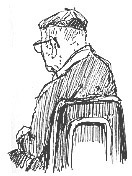Weds
January 15, 2003 at 7.00pm, New Roads School (map)
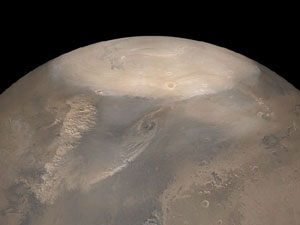 We
will all be taken on a trip throughout the vast dimensions of the Universe
(meaning the stars in the heavens). Mr. Arnie Rosner (member of the O.C
Astronomers Association) who has established an observatory controllable
remotely via the internet, www.arnierosner.com.
The telescopes are located in Arizona and provide the best possible access
to the heavens. Mr. Rosner will link up with the observatory and guide
the telescopes to locations in the sky that will be suggested by our members.
Photographs will be taken using a mounted CCD camera and the images transmitted
back to our class room. The telescopic images will be projected on the
screen for the members to study. Our members will be taken through the
entire process and made familiar with how to use the telescope from remote
access. He is also offering a door prize of two hours of free access to
any member who is lucky enough to have his name pulled from the hat (so
to speak). Please bring a friend or a young person who may have an interest
in astronomy. After this, Alan deHaas will give another talk in his lecture
series on the technology of the microscope, this one focusing on illumination
systems. We
will all be taken on a trip throughout the vast dimensions of the Universe
(meaning the stars in the heavens). Mr. Arnie Rosner (member of the O.C
Astronomers Association) who has established an observatory controllable
remotely via the internet, www.arnierosner.com.
The telescopes are located in Arizona and provide the best possible access
to the heavens. Mr. Rosner will link up with the observatory and guide
the telescopes to locations in the sky that will be suggested by our members.
Photographs will be taken using a mounted CCD camera and the images transmitted
back to our class room. The telescopic images will be projected on the
screen for the members to study. Our members will be taken through the
entire process and made familiar with how to use the telescope from remote
access. He is also offering a door prize of two hours of free access to
any member who is lucky enough to have his name pulled from the hat (so
to speak). Please bring a friend or a young person who may have an interest
in astronomy. After this, Alan deHaas will give another talk in his lecture
series on the technology of the microscope, this one focusing on illumination
systems.
back to Program of Events |
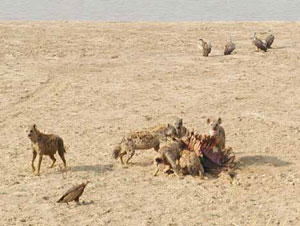 Weds
February 19, 2003 at 7.00pm, New Roads School (map) Weds
February 19, 2003 at 7.00pm, New Roads School (map)
At this meeting, Larry Albright will give a presentation on a recent
African photo Safari to Zambia and Botswana. He will present images of
animals taken during the trip and will describe how one can acquire such
images of animals using digital equipment. If you ever had doubts about
the digital camera, this program should relieve your worries, digital
imaging has indeed arrived. After this, Alan deHaas will give another
talk in his lecture series on the technology of the microscope, this one
focusing on illumination systems.
back to Program of Events
|
| Weds March
19, 2003 at 7.00pm, New Roads School (map)
This month we are expanding on the topic of illumination which Alan deHaas
has given lectures about at past meetings. Mr. Gregg Kleinberg from the
Tamar Technology
Co. will give a presentation on the EtherGlow illumination system
which was designed for the Olympus BHS. This should add to our expanding
knowledge of illumination systems. Mr Kleinberg will introduce the technology,
explain how it works and highlight its unique advantages. In addition
Mr Kleinberg will be accompanied by a colleague, David Marx Ph.D. (optics).
Dr. Marx was the Chief Optical Engineer of Sight Systems, which ultimately
became Tamar Technology. For the presentation they will set up an Olympus
BHS microscope (donated for the evening by John Fedel MSSC member) with
the EtherGlow illuminator. Following this presentation, Jim Solliday (MSSC
President) will show some results that can be gained using the EtherGlow
filter.
back to Program of Events
|
Weds April
16, 2003 at 7.00pm, New Roads School (map)
 This
month, Dr. Ken Gregory (MSSC member and longtime teacher of Anatomy and
Physiology) will give a talk on The Functional and Histological Anatomy
of the Human Gastro-Intestinal Tract. His talk will be accompanied by
slides illustrating peptic ulcerations of the esophagus, stomach, duodenum
and pathophysiology of the colon. The second half of the meeting will
provide an opportunity for members to share what they have been working
on. This
month, Dr. Ken Gregory (MSSC member and longtime teacher of Anatomy and
Physiology) will give a talk on The Functional and Histological Anatomy
of the Human Gastro-Intestinal Tract. His talk will be accompanied by
slides illustrating peptic ulcerations of the esophagus, stomach, duodenum
and pathophysiology of the colon. The second half of the meeting will
provide an opportunity for members to share what they have been working
on.
back to Program of Events |
Weds
May 21, 2003 at 7.00pm, New Roads School (map)
 The
pond life program is undoubtedly one of our best attended and most exciting
meetings! Members are strongly encouraged to bring pond water, ditch water,
fountain water or anything that lives in water. Also microscopes, illuminators
and pipettes and tools to play in the water.(Extra microscopes are always
a good thing to bring for guests to use.)We will also be presenting a
short slide show (7Mb file)
illustrating our field trip to the Madrona Marsh. For those who managed
to attend the field trip you already know what a great success it was
and how valuable a resource this preserve has become. We will show an
introduction to the microscopic life of the marsh using digital imaging.
It will be something you will not wish to miss. The
pond life program is undoubtedly one of our best attended and most exciting
meetings! Members are strongly encouraged to bring pond water, ditch water,
fountain water or anything that lives in water. Also microscopes, illuminators
and pipettes and tools to play in the water.(Extra microscopes are always
a good thing to bring for guests to use.)We will also be presenting a
short slide show (7Mb file)
illustrating our field trip to the Madrona Marsh. For those who managed
to attend the field trip you already know what a great success it was
and how valuable a resource this preserve has become. We will show an
introduction to the microscopic life of the marsh using digital imaging.
It will be something you will not wish to miss.
back to Program of Events
|
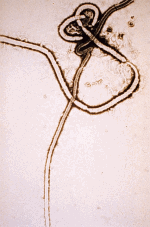 Weds
June 18, 2003 at 7.00pm, New Roads School (map) Weds
June 18, 2003 at 7.00pm, New Roads School (map)
This month Vern Eveland, Ph.D., Professor Of Biological Sciences, California
State University, Long Beach, will be giving a presentation entitled Emerging
Infectious Diseases. Infectious diseases remain an important global problem
in public health, causing over 13 million deaths each year. Emerging infectious
diseases are caused by old, new, and mutant microorganisms, and can be
attributed to changes in the microorganisms themselves, changes in the
characteristics and risk factors of patients, the widespread use of antibiotics
(drug resistance), vector resistance, changes in patterns of travel and
commerce, changes in the environment, xenotransplantation, new technologies
and industry, social disorder, wars, and immunosuppression Dr. Eveland's
talk will focus on some emerging and reemerging infectious diseases and
factors known to influence their emergence. After Dr. Eveland's presentation,
Alan deHaas will continue his lecture series on the microscope. This month,
Alan will discuss the principles of using the microscope eyepiece.
back to Program of Events
|
| 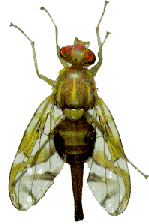 Weds
July 16, 2003 at 7.00pm, New Roads School (map) Weds
July 16, 2003 at 7.00pm, New Roads School (map)
This month our main speaker is Dr. Kevin Hoffman, who is the Senior Insect
Biosystematist for the California Department of Food and Agriculture.
The title of his talk is "Exotic Fruit Fly Exclusion Programs in
California". He will present a general overview of the programs used
in California to prevent colonies of exotic fruit flies from becoming
established, followed by a more specific overview of the Mediterranean
Fruit Fly and its exclusion programs. After Dr. Hoffman's presentation,
Alan deHaas will continue with his lecture series on the microscope. This
month, he will provide an explanation and demonstration of flat-field
optics.
back to Program of Events
|
Weds
August 20, 2003 at 7.00pm, New Roads School (map)
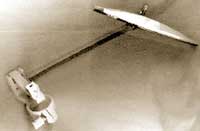 Ken
Gregory, MSSC Program Chair, will facilitate a workshop on drawing through
the microscope. The Camera Lucida was originally designed in 1807 by Dr.
William Wollaston, and adapted for use with the microscope by Professor
Ernst Abbe in the mid 1880's before photography through a microscope became
easy. The principle is really quite simple. The camera lucida is clamped
around the outside of the microscope eyepiece tube, allowing the specimen
to be seen through a prism. At the same time a mirror reflects the bench
surface to the prism, superimposing it on the image from the microscope.
To draw the specimen, you simply trace its outlines to paper. Dr. Ken
Gregory will help introduce this important piece of equipment and set
up a number of exhibits to illustrate its use. After this, John and Leonie
Fedel will demonstrate this new MSSC website to members. Ken
Gregory, MSSC Program Chair, will facilitate a workshop on drawing through
the microscope. The Camera Lucida was originally designed in 1807 by Dr.
William Wollaston, and adapted for use with the microscope by Professor
Ernst Abbe in the mid 1880's before photography through a microscope became
easy. The principle is really quite simple. The camera lucida is clamped
around the outside of the microscope eyepiece tube, allowing the specimen
to be seen through a prism. At the same time a mirror reflects the bench
surface to the prism, superimposing it on the image from the microscope.
To draw the specimen, you simply trace its outlines to paper. Dr. Ken
Gregory will help introduce this important piece of equipment and set
up a number of exhibits to illustrate its use. After this, John and Leonie
Fedel will demonstrate this new MSSC website to members.
back to Program of Events
|
Weds
September 17, 2003 at 7.00pm, New Roads School (map)
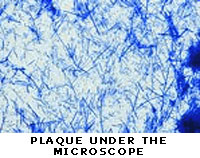 Dr.
Clifton Franklund, Department of Biological Sciences, California State
University, Long Beach will give a lecture on the microscopic analysis
of oral biofilms. Biofilms are populations of microorganisms that adhere
to any environmental surface with sufficient moisture and adequate nutrients.
Dental plaque is an example of the development of a biofilm. Dr. Franklund
will illustrate and discuss the techniques he uses in the study of biofilms,
specifically oral biofilms. His particular research interest is in oral
gingival pathogens. Dr.
Clifton Franklund, Department of Biological Sciences, California State
University, Long Beach will give a lecture on the microscopic analysis
of oral biofilms. Biofilms are populations of microorganisms that adhere
to any environmental surface with sufficient moisture and adequate nutrients.
Dental plaque is an example of the development of a biofilm. Dr. Franklund
will illustrate and discuss the techniques he uses in the study of biofilms,
specifically oral biofilms. His particular research interest is in oral
gingival pathogens.
back to Program of Events
|
Weds
October 15, 2003 at 7.00pm, New Roads School (map)
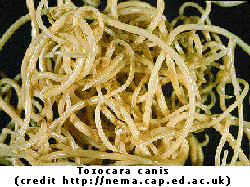 Dr.
Lawrence Ash, Department of Biological Sciences, UCLA, specializes in
parasitology. His lecture is titled "Zoonotic Larval Nematode Infections
and Childhood Diseases." Children, in particular toddler-age children,
are especially vulnerable to becoming infected with parasites occurring
in household pets (ie, dogs and cats) but also parasites of wild animals
living in urban and peri-urban environments.Such infections, deriving
from animals, are referred to as zoonoses or zoonotic infections. Visceral
larva migrans is a syndrome that was first described in the early 1950s
in which young children acquired infection principally with Toxocara
canis, the common roundworm of dogs, but also with Toxocara cati,
a similar parasite infecting cats. With these infections, larval nematodes
invaded a variety of tissues, but especially the liver, the central nervous
system and the eye. Severity of infection was generally dependent upon
the numbers of infective eggs ingested but fatalities were uncommon. Beginning
in the 1980s, a related ascarid parasite of raccoons, Baylisascaris
procyonis, was found to cause severe, often fatal, disease in children.
It is now recognized that this raccoon parasite is well established on
the west coast of the U.S. and a number of cases have been reported from
California. This talk will focus upon the interaction of animals, their
parasitic infections, the external environment where fecal material is
deposited, the influence of weather, and the behavior of adults and children
- all contributing to the public health problem associated with B. procyonis
and other similar nematode infections. Dr.
Lawrence Ash, Department of Biological Sciences, UCLA, specializes in
parasitology. His lecture is titled "Zoonotic Larval Nematode Infections
and Childhood Diseases." Children, in particular toddler-age children,
are especially vulnerable to becoming infected with parasites occurring
in household pets (ie, dogs and cats) but also parasites of wild animals
living in urban and peri-urban environments.Such infections, deriving
from animals, are referred to as zoonoses or zoonotic infections. Visceral
larva migrans is a syndrome that was first described in the early 1950s
in which young children acquired infection principally with Toxocara
canis, the common roundworm of dogs, but also with Toxocara cati,
a similar parasite infecting cats. With these infections, larval nematodes
invaded a variety of tissues, but especially the liver, the central nervous
system and the eye. Severity of infection was generally dependent upon
the numbers of infective eggs ingested but fatalities were uncommon. Beginning
in the 1980s, a related ascarid parasite of raccoons, Baylisascaris
procyonis, was found to cause severe, often fatal, disease in children.
It is now recognized that this raccoon parasite is well established on
the west coast of the U.S. and a number of cases have been reported from
California. This talk will focus upon the interaction of animals, their
parasitic infections, the external environment where fecal material is
deposited, the influence of weather, and the behavior of adults and children
- all contributing to the public health problem associated with B. procyonis
and other similar nematode infections.
back to Program of Events
|
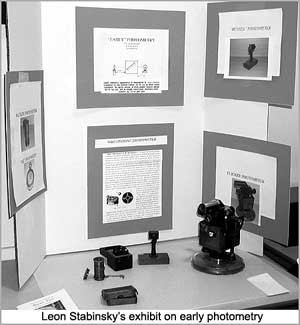 Weds
November 19, 2003 at 7.00pm, New Roads School (map) Weds
November 19, 2003 at 7.00pm, New Roads School (map)
This is the annual Exhibition Meeting of the Society. This is one of
the best events of the year and is a great deal of fun. Each member is
encouraged to bring along an exhibit to share.Anything associated with
microscopic subjects is welcome. Your exhibit could be simple, for example
you could set up your microscope with your favorite slide.
A projector will be provided for those bringing 35mm slides. Posters
and display boards are also encouraged, along with the usual sales table.
Please remember to bring a label or piece of paper with a brief description
of your exhibit.
See Leon Stabinsky's exhibit (left) from the Exhibition Meeting in November
2002.
back to Program of Events
|
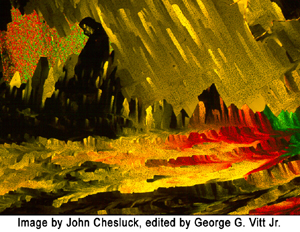 No
December meeting, instead the MSSC Holiday Banquet, December 14,
2003 4:00pm -8:00pm No
December meeting, instead the MSSC Holiday Banquet, December 14,
2003 4:00pm -8:00pm
Members are invited to the MSSC Holiday Banquet at the Hollywood Hills
Restaurant, 1745 North Vermont Avenue, Los Angeles, CA 90027 (map),
Phone: (323) 661-3319. The cost for each person is $22.70 ($45 per couple),
please make your checks payable to our Treasurer Dave Hirsch. Send checks
and your choice of meal (grilled chicken breast, grilled salmon or vegetable
lasagna) to Pete Teti. After the dinner a slide show with music will be
presented on the topic "Exploring crystals through the microscope."
This show will be our third in the series recognizing the contribution
of MSSC member John Chesluk.
back to Program of Events
|

